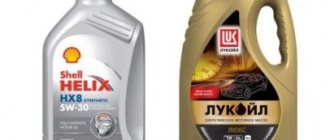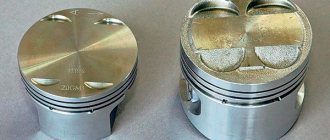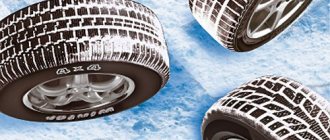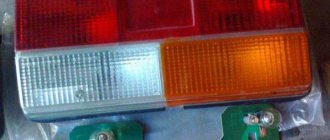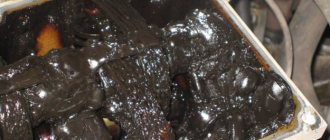To rinse or not to rinse
When changing oil, it is drained from the bottom of the engine and filled from above. At the same time, you don’t have to be an expert to understand that when the oil is drained, some part still remains on the walls and in other parts of the engine, inevitably mixing with the newly filled oil. Therefore, probably, at first glance, when asked whether the engine needs to be flushed when changing the oil, the answer suggests itself in the affirmative.
But is it really that simple? Why is there so much controversy about this?
Exceptions when changing oil
There is one exception in which it is allowed not to flush the engine when changing the oil. It says that if the oils in the car were changed in the order: mineral water, semi-synthetic, synthetic, then flushing is not necessary. In order to fill in 5W40 oil in reverse order, it is necessary to flush.
Flushing is carried out using a special flushing lubricant and its essence is that after removing the already used fluid from the crankcase, flushing is added. After it is filled, the car needs to be idled for about 10-15 minutes. During this time, flushing will remove all the large amount of chips that were previously present, which have settled on the walls and the remnants of the previous lubricant. Flushing will also remove all accumulated dirt in the engine and after that you can pour in brand new 5W40.
Filling with 5W40 synthetic promotes better engine performance. It treats existing microcracks using a special material contained in a set of additives. 5W40 can increase compression, thereby increasing engine power.
Experiment
One of the online publications specializing in lubricants decided not to rely on companies’ marketing moves, but to experimentally find out whether it is necessary to flush the engine when changing oil from mineral water to semi-synthetic, synthetic, from semi-synthetic to synthetic, and so on.
The experiment proceeded as follows. Oil was poured into the car: after mineral water - semi-synthetic, after semi-synthetic - synthetic, after synthetics - synthetic again, and also in the reverse order. All possible options for switching from one type of oil to another were tried. Each time, two replacement methods were used: with and without engine flushing. Each time we took a sample of used oil and compared the indicators where the engine was washed and where it was not washed.
Based on the results of the experiment, it turned out that without flushing the oil performs better in cases where mineral water is changed to semi-synthetic, semi-synthetic to synthetic, and one type to the same. Therefore, when asked whether it is necessary to flush the engine when changing oil from semi-synthetic to synthetic, you can answer: no, it is not necessary. However, in the reverse order, that is, when replacing from synthetics to semi-synthetics and from semi-synthetics to mineral water, the results showed that the oil deteriorates if the engine is not flushed.
Optical density
Optical density is the factor due to which washing is absolutely necessary. You can do a flush to change the lubricant from semi-synthetic to 5W40 synthetic, since a large number of studies have confirmed that the engine starts to work much better.
Optical density is microscopic granules that create an oil film. In mineral and semi-synthetic oil they are all unequal in size and it is because of this factor that gliding occurs much worse. Synthetic lubricants cover the rubbing surfaces of parts with a uniform film. But the presence of this uniform film is possible only after thoroughly flushing the engine with oil.
If a car owner cares about his car, then it is best to do a double wash. This will completely get rid of lubricant particles deposited on the cylinder walls. In this case, after new oil is poured, it will spread evenly throughout the crankcase and other engine components.
Whether to flush or not, the choice remains with the owner. This is necessary more when oil is poured into a purchased used car for the first time. This will eliminate the possibility of unnecessary impurities and other elements getting into the new oil.
Why do you need to flush the unit?
To understand this issue, you need to understand how oil works in the engine. After all, it lubricates not only those parts that move, but also cleans them. All dirt is washed off the walls and mixed with it, causing the oil to become darker and its viscosity to increase.
It is clear that it contains detergent additives. However, after refueling, their decomposition process immediately begins, and with increasing mileage their properties deteriorate. In the end, they simply cannot solve their problems. Moreover, up to twenty percent of the oil remains in hidden cavities during replacement. And, as you know, it contains dirt, which immediately mixes with the new one. That is why each replacement, even with good quality, leads to a deterioration in the operation of the unit, and to the question of whether it is necessary to flush the engine when changing the oil, the answer will be clearly positive.
But there are some clarifications here.
Mixtures with different viscosities
A very important parameter for motor oils is viscosity (fluidity), which affects the change in the structure of the motor mixture at different temperature conditions. Before mixing semi-synthetic with synthetic, pay attention to the markings indicating the viscosity of the motor fluid. For example, the inscription SAE 10w-40 indicates an all-season fluid; by mixing it, for example, with 5w-20, you will get a motor oil with an average viscosity, its characteristics will be close to the motor oil of which more is poured into the engine. Please keep in mind that 10w-40 is much thicker than 5w-20; the resulting mixture will liquefy faster at high temperatures, which can lead to the formation of an insufficiently dense protective film in the friction units of parts and engine wear. It is not recommended to drive on this oil for a long time. Since its properties will deteriorate with increasing mileage, it will not be able to protect the engine from wear.
If you add semi-synthetics of higher viscosity to your car and reduce the fluidity of the mixture to a critical value, the liquid will be very thick and will not be able to penetrate the friction units, the engine will operate with dry friction of the parts.
When reducing the low-temperature indicator of the engine mixture, keep in mind: this parameter affects starting the engine without warming up; by warming up the power unit, you reduce the life of the engine fluid; it must be replaced before the regulated mileage by the oil manufacturer.
It is completely unacceptable to use semi-synthetics for a new motor filled with energy-saving synthetics; this will lead to the formation of carbon deposits on the piston group at high temperatures, plus semi-synthetics will prevent the reduction of friction between the drive elements, the motor cannot be used at its maximum power.
When
Based on the experiment conducted above, we can answer the question of whether it is necessary to flush the engine when changing the oil. The answer depends on what kind of oil was and what kind will be filled.
It is clear that when replacing from mineral water to semi-synthetic, from semi-synthetic to synthetic and from synthetic to synthetic, the replacement will not improve performance. Therefore, in this case it is quite possible to do without washing. In addition, if the machine is operated by one person, he may well not wash it every time. However, if replacement has been done in this way several times already, then it is still worth doing the flushing.
At the same time, there are situations when it is necessary to change the oil:
- when switching from synthetics to semi-synthetics or mineral water, or from semi-synthetics to mineral water, as well as oils of different viscosities;
- when purchasing a used car, since it is not known what kind of oil was filled in and how often the previous owner changed it;
- with constant use, when they drive a lot and quickly, naturally, more lubrication is also required;
- after a major engine overhaul;
- if you suspect that debris or other substances have entered there;
- on turbocharged engines, which are especially sensitive and require clean and high-quality oil.
Subtleties of switching from semi-synthetics to synthetics
Each motor oil is manufactured according to established standards. Manufacturers are not obliged to include aggressive additives in their composition, which lead to the coagulation of technical fluids. There is also a motor oil compatibility table. Therefore, if all the technology was used correctly by the manufacturers, then when mixing two oils of different production, they should completely dissolve and without separation. If you have doubts about this, you can conduct the experiment at home. If, when mixing the compositions, a completely homogeneous mixture is obtained, this can only mean one thing - the oils are completely compatible. However, flushing the engine during replacement may be necessary if you plan to switch to a lower quality oil. That is, when you plan to fill in mineral oil or semi-synthetics instead of synthetics. Also, flushing the engine is mandatory when manipulations were carried out with the power unit as a result of which foreign substances could get inside it. Flushing should also be carried out if there is a suspicion that low-quality oil, antifreeze or fuel has been filled.
New cars
Drivers who have bought a new car are especially sensitive to it and try to comply with all the manufacturer’s instructions and even more. People often wonder whether it is necessary to flush the engine when changing the oil after break-in. There are no strict operating instructions for this case. If the vehicle has been used properly, this procedure is not necessary. At the same time, you should take into account what kind of oil is filled in and which one is planned to be filled.
Now, to the question, for example, whether it is necessary to flush the engine when changing oil from synthetic to synthetic, you can give the correct answer. But another question arises - how to flush the engine correctly.
Methods
There are several ways to flush the engine, most of which, if you think about it, do not fulfill their function. Let's look at them briefly.
The flushing oil will make the dirt residue not as concentrated as before. However, the deposits will not be dissolved, much less washed away.
The vacuum pump is used in the so-called express replacement. Moreover, they say that the used oil will be pumped out 100%, but this is impossible for the simple reason that in any case it will not be able to reach the hidden cavities.
“Five-minute” quick washes are poured for just a few minutes, turn on the motor, and then drain. Such washings, in addition to being useless, are also dangerous. As a result, the deposits not only do not dissolve, but also clog the channels, causing the engine to lack lubrication in some parts. In a car service, of course, they can object to this and say that if you use the most effective means, they will cope with their task. This may be true, but at what cost? The fact is that such concentrated chemistry can, together with dissolving deposits, damage and corrode the crankshaft rubber seals. Because of this, leakage will occur and the seals will have to be changed, which is not easy.
But if so many methods are useless, then is it necessary to flush the engine when changing the oil in a VAZ 2107, Opel, Skoda, BMW or any other car in general?
Sometimes a long washing method is suggested as the most effective. You will need to spend a little more time on it; it consists in the fact that liquid is poured into the engine, with which they drive from fifty to five hundred kilometers, after which it is replaced. During this time, dirt and deposits have time to wash off and dissolve without harming the power unit. Manufacturers present special combined compositions for this, which, according to them, can not only wash the inside of the engine, but even to some extent restore the structure of parts rubbing against each other.
Five-minute and long-lasting liquids: what really happens
For those who are in a hurry, the car service center can offer a liquid for quick flushing. For those who “care” about their vehicle - a combined composition for driving it a little and then replacing it with oil. But how will they actually behave?
It is usually written on the packaging that such products are safe for oil seals and seals. However, if you think sensibly, then this is impossible, since flushing requires an aggressive environment to deal with deposits. Therefore, at least the removable caps will be seriously damaged because of them.
You can also find o, which is also incredible, considering that approximately fifteen percent of each manufacturer’s oil has its own unique composition. Therefore, it simply will not be possible to influence all of them equally.
The promise that the mobility of the piston rings will be restored thanks to the fluid does not stand up to criticism. The only thing that is possible in this case is spraying the worn mechanism. But how realistically can this restore metal? The question is, of course, rhetorical.
Bottom line: what to do?
When wondering whether it is necessary to flush the engine when changing oil from mineral water to synthetic or in other specific situations, you need to take into account several points at once and only then draw a conclusion. However, if you decide to flush, then this should not be done with any special means or devices, but only with engine oil.
This happens as follows:
the oil is drained and the oil filter is changed;
new oil is poured in, a filter is inserted and the car is driven for a couple of days at low speeds;
The oil is drained again and new oil is added, and the next change is made not after ten thousand kilometers, but after seven.
It is in this way that the life of the engine will be extended and questions like whether it is necessary to flush the engine when changing oil from synthetic to synthetic and other types will disappear by themselves.
How and in what cases is oil changed from semi-synthetic to synthetic? In the world of motorists, one very serious question often arises about whether it is possible to fill in synthetic-based oil after using a semi-synthetic lubricant. You often hear the opinion that this can be done and there is no need to fear anything. But the wrong answer can ruin the engine and lead to severe anxiety, and most importantly, to expensive repairs.
When choosing an oil, you must be guided by the car manufacturer's requirements for the oils and liquids used.
Let's sum it up
Semi-synthetics can be added to synthetic oil in emergency situations, but the following must be taken into account:
- Adding another motor mixture to the oil composition can improve some of its properties and worsen others.
- The viscosity of the liquid obtained by mixing should not reach a critical value. Too thick or thin mixtures lead to dry friction of engine parts.
- Additive packages from different brands of motor oils may be incompatible with each other, so it is better to add oil from the same manufacturer.
- You can mix synthetics with semi-synthetics of the same brand with the same viscosity without noticeable harm to the drive.
It is unacceptable to drive for a long time on a “cocktail” of motor oils - the properties of the liquids will deteriorate with increasing mileage. Therefore, change the engine oil as soon as possible.
General information
To choose the right oil, it is necessary to monitor the market.
The presence of a huge number of oils on the market creates another trap for inexperienced drivers. It seems to many that the use of certified and high-quality products certainly cannot lead to any sad consequences. Changing oil from semi-synthetic to synthetic does not seem to them to be a step in a dangerous direction. Moreover, such a transition is often practiced by motorists and usually does not have disastrous consequences for the engine.
To choose the right oil, it is necessary to monitor the market.
But this is a big misconception. Even oils that are manufactured to the highest standards can be hazardous to engines if used incorrectly.
To begin with, when purchasing a certain brand of car, you need to find out which specific oil is suitable for the purchased vehicle: synthetic or semi-synthetic, what is the standard of the product. This is very important because oil is the second fuel in the fuel and lubricants system. It is consumed, like gasoline, lubricating metal parts and mechanisms. A car cannot operate without oil; its choice must be approached no less responsibly than the purchase of gasoline.
Synthetics
Synthetic motor lubricant is the most proven type of oil. It is created in laboratories under strict control and using complex chemical transformations. It has an unrivaled molecular lattice formula. Thanks to this, it almost does not react with metal and practically does not deteriorate. It has perfect viscosity, which cannot be seen in any other type of motor product. Chemical impurities of synthetics are a good replacement for 5W40 mineral oil.
A huge advantage is that synthetic motor oil already contains the necessary additive package - this means that there is no need for additional costs that are required, for example, in mineral water. Another disadvantage of mineral water is that additives tend to evaporate from the composition, but synthetics do not have such a disadvantage.
Additives add a wide range of capabilities to an engine. Among them: easy starting in the winter season, improved compression, lower fuel consumption. These parameters are ideally combined in 5W40 oil; it stands out for its freezing point of -30 degrees. Such a high indicator will allow it to be used even in the most remote regions of Russia.
The mass remains thick even at a temperature of +30 degrees. Replacing it with it will reliably protect the car from a large number of breakdowns and engine-related problems. Unlike mineral, synthetics are completely chemical in origin due to laboratory synthesis.
The only downside is the price. Not everyone can afford fairly expensive engine maintenance. And in the case of operating a domestic car, there is practically no point in overpaying for quality, since Russian engines are not very picky about the quality of oil and also do not need frequent replacement.
Is it possible to pour synthetics after semi-synthetics?
This question cannot be answered easily. It is necessary to understand the susceptibility of engine units to certain types of oil. For example, engines operating with mineral lubricant are quite difficult to start at low temperatures due to changes in the viscosity level of the lubricant. These and other properties play an important role in the influence of oil on the operating process of the engine.
Material based on synthetics or semi-synthetics is much less susceptible to low temperatures. But in this situation there is no need to go to extremes and use the product that seems to be of higher quality and more effective in cold weather. This is fraught with big troubles for the car owner and a technical malfunction for the vehicle itself.
You should be careful when mixing synthetics with semi-synthetics.
Today in the automobile market, most of the cars purchased already have some mileage. This means that they have already driven on a certain fuel and oil. However, the instructions will not indicate what oil was previously used in the car engine. Therefore, when purchasing, you need to find out from the previous owner what specific lubricant he used during operation of the vehicle.
If an oil change occurs in which semi-synthetics are mixed, even with synthetic residues, this can lead to undesirable consequences. In some cases, it is contraindicated to use synthetic material as motor oil because it has very high fluidity. For example, if there are oil seals and seals among metal structures, synthetics will begin to enter into a chemical reaction with them, thereby destroying them.
Often all the arguments boil down to the fact that you cannot change semi-synthetics to synthetics or this should be done with mandatory engine flushing. In fact, it is possible to change the lubricant in increasing increments without flushing the engine. This means that you should first use a mineral product, then a semi-synthetic and only then a synthetic. This procedure will protect the car mechanism.
To sum up, we can draw two conclusions:
- Replacing semi-synthetics with synthetics of the same brand is generally safe and does not require flushing the engine.
- It is possible to replace synthetics with semi-synthetics, but it is necessary to flush the engine.
However, these conclusions are not always true. It is worth noting that domestic cars have their own specifics: they work well on semi-synthetic lubricants, but react poorly or do not tolerate synthetic products at all. Domestic brands have such a reaction to synthetics: UAZ and GAZ. Therefore, in models of these brands, no replacement of semi-synthetics with synthetics is made.
Oil change tool kit.
In other cases, replacing semi-synthetics with synthetics is quite appropriate and safe, and does not require flushing the engine. Moreover, according to experienced motorists, flushing the engine after using a semi-synthetic material and switching to a synthetic one will deprive the engine of some useful properties.
It turns out that the optical density of the synthetic oil used will be noticeably lower if the propulsion system has been previously flushed.
If you treat with flushing materials every time before the upcoming replacement of the oil element, this leads to a longer retention of fresh oil in the inside of the engine.
At first it seems that this is good, but at the same time the resistance to oxidative processes is reduced.
Engine flushing is necessary in cases where:
- The brand of lubricant changes.
- The viscosity level changes.
- When is the transition from synthetics to semi-synthetics made?
- When there are doubts about the quality of the oil material in the engine or low-quality fuel has entered the oil.
- After any engine repair that involved opening the engine.
- When the driver had doubts that the previous owner regularly changed the engine oil.
Without flushing, about 10% of the semi-synthetic material remains in the engine, but it does not play any negative role. The synthetic material does not experience problems in the presence of another element.
Rules for replacing semi-synthetics with synthetics
The best option when replacing semi-synthetics with synthetics is to use fluids from one manufacturer. However, this is not a mandatory condition.
An important requirement for all motor oils is established by law: compatibility of different materials with liquids from any other manufacturer. This is necessary to comply with international standards such as API and ACEA. Otherwise, such goods cannot be put into circulation.
Oils can be mixed regardless of their viscosity and operating temperature conditions. In this case, the characteristics will be averaged. This is especially true for materials from the same manufacturer, since they have almost the same base and additives that will not conflict with each other.
If, however, oil additives from different manufacturers begin to conflict, they will not cause any harm to the engine. In this situation, material consumption will increase during the first five thousand kilometers, but the loss will not be critical. This composition should be replaced a little earlier than recommended by the manufacturer.
However, only material of the same or higher quality is poured into the engine oil present in the engine - synthetics are added to semi-synthetics.
To do this, you need to drain the waste material as much as possible and blow out the system using a compressor. If a little old fluid remains in the engine (up to 10 percent), no negative consequences will follow.
But the possibility of purchasing counterfeit products or other problems cannot be ruled out.
In any case, it would be a good idea to check the compositions for compatibility. To do this, you can combine a small amount of oils of different categories. If they are completely mixed without separation, clouding and the formation of foreign impurities, then you can safely pour synthetics after semi-synthetics.
How to flush the engine?
Flushing the engine is a standard and necessary method of prevention, which must be carried out from time to time to clean the parts and mechanisms in the unit. But this does not need to be done after every oil change. Flushing the engine is carried out as follows:
- The machine does a small roll for 10 or 15 minutes. Then you need to stop it and turn off the engine.
- It is necessary to stop the car on an overpass or over a prepared pit in which the driver could work without interference.
- The hood opens, the old filter is unscrewed, and the fluid begins to drain from the engine using a hose. It should flow until it drains completely. Nothing should drip. To allow more fluid to flow out, the machine can be tilted left and right.
- The car is left alone for half an hour.
- New oil is poured in and a new pre-purchased filter is installed.
- You need to drive for several days without restarting the engine.
- The procedure for replacing the lubricant is carried out again, and the filter is also changed to a new one again.
general information
Inexperienced motorists who live in the Russian Federation believe that the use of licensed and high-quality oils is absolutely safe for the engine and is not capable of causing problems. The transition from semi-synthetics to synthetics is often carried out by car owners, but it must be done correctly.
Determining oil quality by shade
When purchasing a car, you need to make sure which car oil is optimal for pouring into it. This is of great importance because oil fluid is the second most important consumable after fuel. The car will not drive without oil, so you need to choose it as carefully as you choose fuel.
Only after a thorough clarification of the technical characteristics of the lubricant and the selection of a suitable consumable can you begin the replacement procedure. It is simple enough even for an inexperienced motorist. However, today every driver has the opportunity to contact a specialized service center. Its employees, for a certain fee, will quickly and efficiently change the lubricant in the engine of your vehicle.
A good option is to seek help from an experienced motorist. Of course, the recommendations of the car manufacturer are of great importance, but the opinion of someone who drives a car every day for a long time is also important.
Filling synthetic motor oil after semi-synthetic
Semi-synthetic lubricants, like synthetic ones, work well in low-temperature conditions. Nowadays, most cars on the car market already have a certain mileage. This means that they have already driven on some kind of fuel or oil. At the same time, it is not indicated anywhere what kind of oil was previously poured into the engine. In view of this, when purchasing a used car, you need to check with the seller what kind of lubricant he used.
Certain engines should not be filled with synthetic oil. This is due to the fact that such petroleum products are fluid and can destroy oil seals and sealing elements.
Summarizing all of the above, it is possible to draw 2 conclusions:
changing semi-synthetic oil to synthetic oil is not dangerous and does not involve flushing the power unit;
If you switch from synthetic motor oil to semi-synthetic, you need to flush the engine.
It must be said that Russian cars have their own specifics. They drive great on semi-synthetics, but react negatively to synthetics. In view of this, if you have a UAZ or GAZ car, you should not replace one lubricant with another.
In general, it is necessary to flush the power unit when:
- changing the brand of oil fluid;
- changes in the viscosity index of the lubricant;
- changing synthetic motor oil to semi-synthetic;
- low-quality motor oil/fuel getting into the engine;
- disassembling the power unit;
- prolonged use of lubricating fluid that has exhausted its service life.
Without flushing, approximately ten percent of semi-synthetics remain in the engine. They cannot in any way affect the properties of synthetics.
Different base foundation
Motor mixtures consist of a base base and additives added to it. The base affects the properties of the oil, and additives help highlight certain characteristics of the motor fluid, for example, anti-corrosion or detergent properties.
The basis of motor oils consists of molecules of a certain structure and size. The more homogeneous the molecules, the better the characteristics of the liquid. Synthetic mixtures are produced using the synthesis of hydrocarbon compounds. Their structure is presented in the form of long chains of carbon atoms of the same shape - this ensures the resistance of synthetics to changes in its structure under different temperature conditions and heavy loads.
Figure 1. Mineral oil.
Semi-synthetics are made by mixing synthetics and mineral water in certain proportions. Mineral water molecules are different in shape, so semi-synthetic liquids have molecules in their structure that are different in shape and structure - this reduces the range of their operating temperatures.
Figure 2. Synthetic oil.
Figures 1 and 2 show molecular simulations of the molecular structure of synthetic and mineral oil, respectively. It is not difficult to determine where the density is better and there is more slip.
Obviously, by mixing semi-synthetics with synthetics, you will worsen the properties of the motor fluid. You can learn more about the basic basis of motor oils from the video:
Flushing the power unit
Flushing the engine is a standard and effective method of prevention. Washing must be done periodically to clean motor parts. However, flushing does not have to be done after every oil change. Washing is done like this:
- Drive for ten to fifteen minutes. Turn off the engine.
- Place the car on a special ditch or overpass.
- Open the hood cover, unscrew the installed oil filter, and drain the lubricant from the engine using a hose. All oil fluid should flow out. To speed up the draining of oil products, tilt the car to the left and right.
- Wait thirty minutes.
- Fill with fresh consumables, install a new oil filter.
- You need to drive for a couple of days without subjecting the engine to high loads.
- Repeat changing the consumables, change the oil filter again.
The next wash should be done much earlier. This is due to the fact that after purchasing a car, the oil fluid must be replaced upon reaching five thousand kilometers. Then the lubricant must be changed every ten thousand kilometers. Subsequent intervals increase to twenty thousand kilometers.
This is all that a motorist needs to do when changing the oil fluid or flushing the engine. It’s not difficult; almost any car owner can change the lubricant today. The main thing is to choose the right consumables, and do not forget to flush the engine (when filling in a semi-synthetic lubricant instead of a synthetic one).
